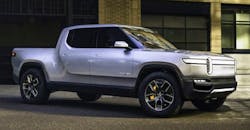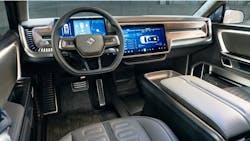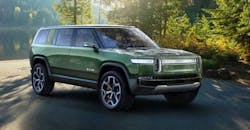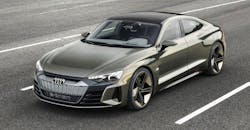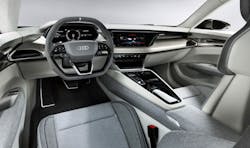Auto shows attract EVs from companies big, small, and in between. For example, at the recent Los Angeles auto show (which convened in November-December of last year), brought out new EVs from a low-profile company, Rivian, which you probably never heard of, and Audi, a high-profile player in the automobile industry that’s quite well-known. Whether the EV was from a big or small company, their EV technologies definitely reflect future trends.
Little was heard from Rivian since its founding in 2009. This changed in November 2018, when it showed up at the L.A. Auto Show with an all-electric, five-passenger pickup truck. Designated the R1T, it features a range of up to 400+ miles (Fig. 1).
1. The RIT’s quad-motor system delivers 147 kW with precise torque control to each wheel.
Rivian packages the battery pack, drive units, suspension, braking, and thermal system all below the height of the wheel, leaving the space above for occupants and their gear. This results a low center of gravity that aids the vehicle’s agility and stability. It also incorporates a sophisticated suspension architecture with unequal length double-wishbone suspension in the front and a multi-link suspension in the rear.
The R1T’s quad-motor system delivers 147 kW with precise torque control to each wheel, enabling active torque vectoring and maximum performance, from high-speed cornering to low-speed rock crawling. With 3,500 Nm of grounded torque for each wheel, the R1T can reach 60 mph in three seconds and 100 mph in less than seven seconds. This powertrain and chassis also enable the R1T’s tow rating of 11,000 pounds. In addition, it features three 110-V outlets and integrated compressed air. Three 110-V outlets let you tap into that big battery for powering up tools and gear(Credit: Rivian)
Battery System
Rivian’s battery module has tough underbody protection and an advanced cooling system. Adaptive control algorithms learn driver behavior, optimizing user-specific battery management for maximizing battery life, reliability, and second-life reusability. Three battery sizes are planned, with the 180 kWh and 135 kWh available at launch and a 105-kWh version available within six months.
Battery has charging rates of up to 160 kW, enabling approximately 200 miles of range to be added in 30 minutes. Besides fast-charging, an 11-kW onboard charger facilitates rapid charging at Level 2.
Rivian’s connected car platform operates on a high-speed Ethernet backbone that allows for robust security (Fig. 2). This platform supports granular over-the-air updates of vehicle software to enhance functionality and improve performance. These vehicles connect to a cloud ecosystem for data exchange and processing, enabling machine learning and data services. The digital experience extends beyond the vehicle into the cloud ecosystem and mobile/web applications and provides a consistent and seamless interface for vehicle status and control.
2. The RIT has a digitized dashboard with a custom 15.6-in. center touchscreen, 12.3-in. instrument cluster, and a 6.8-in. rear touchscreen.
Self-Driving
The R1T will launch with a robust hardware suite with camera, LiDAR, radar, and ultrasonic and high-precision GPS coupled with high definition maps. This hardware enables “Level 3” (hands-off wheel and eyes off road) autonomy for highway operation. Beyond the highway Level 3, the vehicle will have a range of self-driving features focused on enabling active lifestyles.
Safety features include eight airbags for occupant protection and reinforcements of the platform to protect the battery. The R1T will be offered with a full complement of active safety systems made possible by Rivian’s suite of self-driving sensors.
Electric SUV
At the Los Angeles auto show, Rivian also introduced an all-electric sport utility vehicle, the R1S (Fig. 3). Based on the same platform as the RIT, the truck and SUV are fully electric vehicles made to both go the distance and get through rough terrain on the way.
3. The R1S SUV is based on the same platform as the R1T pickup truck.
Sharing underpinnings and most capabilities with the RIT, the R1S utility has the square-bodied, ready design of a Rover and the large footprint, tall stature of a Jeep. Its front fascia, however, has a flat face instead of a grille and odd vertical ovals for headlamps.
Rivian has development centers in Plymouth, Mich.; San Jose, Calif.; Irvine, Calif.; and the UK. The company will produce vehicles at its modern, 2.6-million-square-foot manufacturing plant in Normal, Illinois.Three 110-V outlets let you tap into that big battery for powering up tools and gear(Credit: Rivian)Three 110-V outlets let you tap into that big battery for powering up tools and gear(Credit: Rivian)Three 110-V outlets let you tap into that big battery for powering up tools and gear(Credit: Rivian).
Audi Intros Four-Door Coupe Concept Car
Developed in collaboration with Porsche, Audi’s new four-door coupe concept car features a flat-floor architecture with a low center of gravity. Permanent all-wheel drive with torque vectoring transfers torque to the wheels. Its lightweight body has a roof section made from carbon along with numerous aluminum components and supporting elements made from high-strength steel. The project will be developed into volume-production models by the end of 2020. Initial deliveries will be early 2021.
Together with the targeted airflow of the body, large air inlets in the front effectively cool the assemblies, battery and brakes. Airflow hugs the body, reducing undesired swirl (Fig. 4).
4. Audi’s four-door coupe concept car has large air inlets that aid cooling of internal systems.
A center console with a large touchscreen in the top section and the line from the door rail and cockpit frame the driver’s workplace (Fig. 5). The center console and the freestanding instrument cluster seem to float. The screen of the central instrument and the touchscreen above the center console come with a black-panel look finish.
5. Shown is the instrument panel on Audi’s new concept car.
Various layouts are available for the monitors to present the functions depending on the driver’s preference, including virtual instrument dials, easy-to-read navigation maps with information on the range, or various infotainment function menus. They’re controlled via the touchscreen with tactile feedback.
Performance and Range: The Drive
The all-electric drive provides 434 kW (590 hp) of system power. Separate synchronous motors are fitted to the front and rear axles. They put down the torque onto the road via all four driven wheels. There’s no drives between the axles as well as between left and right wheels, providing optimum traction and just the desired amount of slip.
In the future, the vehicle should accelerate from 0 to 100 km/h (0 to 62.1 mph) in around 3.5 seconds before going on to 200 km/h (124.3 mph) in just over 12 seconds. The top speed is regulated at 240 km/h (149.1 mph) to maximize the range. One feature is the option of fully utilizing the drive’s acceleration potential several times in succession. The Audi e-tron GT concept can provide the driver with the full potential of both motors and the battery thanks to its sophisticated cooling strategy.
The range of the concept car will be over 400 km (248.5 miles), based on the new WLTP standard. The required drive energy comes from a lithium-ion battery with an energy content of more than 90 kWh, which takes up the entire underfloor area between the front and rear axle with its flat design. The car’s extremely low center of gravity benefits dynamic handling.
The recuperation system increases the range by up to 30% on Audi electric vehicles. The recuperation involves both the two electric motors and the electrohydraulically integrated brake control system. Different recuperation modes are combined: manual coasting recuperation using the shift paddles, automatic coasting recuperation via the predictive efficiency assist, and brake recuperation with smooth transition between electric and hydraulic deceleration.
Up to 0.3 g, the Audi e-tron GT concept recuperates energy solely via the electric motors, without using the conventional brake—that covers over 90% of all decelerations. As a result, energy is fed back to the battery in practically all normal braking maneuvers. The wheel brakes are involved only when the driver decelerates by more than 0.3 g using the brake pedal. The Audi e-tron GT concept features high-performance ceramic disks that also operate with multiple extreme decelerations without compromising braking performance.
Battery Charging
You can charge the battery using:
- Wired charging with a cable connected behind the flap in the left front wing
- Wireless charging with an integrated coil charging pad installed permanently on the floor where the car is to be parked.
Wired charging is much faster as the four-door coupe is fitted with an 800-V system. It takes around 20 minutes to recharge the battery to 80% of its capacity, providing a range of more than 320 km (198.8 miles) (WLTP). The e-tron GT concept can, however, also be recharged at charging points with lower voltages, providing the driver with access to the entire charging network.
By 2025, Audi will offer 12 automobiles with all-electric drive in key markets worldwide and achieve roughly one-third of its sales with electrified models. The SUVs within this portfolio include the Audi e-tron and the Audi e-tron Sportback, which is due to make its debut in 2019.

